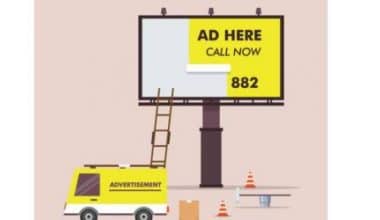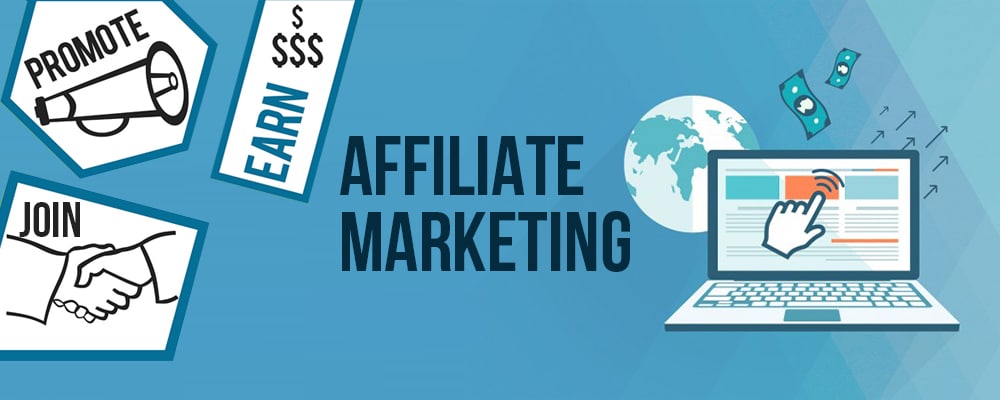Up until recently, banner ads did not exist. However, banner ads are the way to go for excellent ad placement and have reinforced their importance in revenue growth for marketers.
So, what is banner advertising and how does it work? We have a shortened version that you may use to explain them to anyone. We also have a guide on how to create banner advertising, the costs, and banner ads examples to learn from.
Placing a tailored ad on another website is what banner advertising is all about. The ad is shaped like a banner, a large rectangle that can be horizontal or vertical. Banner ads are typically located at the top or bottom of a website, or vertically along the side, adjacent to the primary content.
Banner ads have been there since the internet’s inception, allowing website owners to sell ad space in the same way that a billboard or bulletin board owner would.
While some website owners sell ads directly, the majority work with advertising agencies such as Google AdSense, which generate the ads, determine how much to charge, and then display them on your website.
How Does Banner Advertising Work?
Internet advertising has evolved from a risky venture to a major platform for most organizations’ marketing. In the United States, annual revenue growth in digital advertising remains in the double digits, with a revenue forecast of $138.9 billion in 2020.
Banner advertising, often known as display advertising, comprises static or moving graphics or media and is typically put in high-traffic locations on popular websites. It is appealing since it may help raise brand awareness, generate leads, and retarget a certain group (such as giving a visitor a chance to sign up for a newsletter or free trial before they click away).
Banner advertising works in the same way as traditional advertising does; however, the process by which the advertiser pays the host can differ significantly from traditional ad space sales. The host receives payment for the banner advertisement in one of three ways: cost per impression (payment for each website visitor who sees the ad), cost per click (payment for each website visitor who clicks on the ad and visits the advertiser’s website), or cost per action (payment for each website visitor who clicks on the ad, visits the advertiser’s website, and completes a task, such as filling out a form or making a purchase).
Facebook Ads and Instagram Sponsored Ads are two examples of the evolution of traditional banner advertising. In 2022, Facebook is expected to account for around 42.5% of online display advertising spending in the United States. Digital display ad spending (including banner ads, video, rich media, and sponsorships) has continued to rise in recent years, which is consistent with the trend in internet advertising. By 2020, digital advertising, which includes banner ads, will account for 31.5% of all online ad spending.
How To Create Banner Advertising
To get started with generating banner ads, marketers need to consider a few important ideas and actions.
- Outlining the goals and objectives of the brand. Brands must consider what success looks like in a banner ad campaign and what action viewers should take after seeing the banner ad.
- Developing a budget. Before starting a banner ad, it is critical to understand how much a brand is ready to commit in order to determine how much advertising spending may be allocated to the ad.
- Identifying the appropriate audience. Who is the advertisement aimed at? Making sure the brand has the right audience in mind for the banner ad has an impact on the ad’s overall success.
- Make the appropriate CTA. What do brands want their customers to do? This could include learning more about the brand or clicking on the advertisement to subscribe to their newsletter on their website.
- What will the advertisement look like? This should be guided by the brand’s business objectives as well as its creative vision. Creatives for banner ads should think about branding logos, high-quality imagery, clear language, and overall company branding.
These elements are critical for a brand to provide the framework for what success looks like and to guarantee that the creative vision of the banner matches the business purpose.
The Costs of a Banner Advertising
Depending on the type of campaign you’re attempting, banner advertising might be fairly cost-effective. The cost of a click can range from a few cents to hundreds of dollars, depending on the type of site you’re advertising on and the target population you’re attempting to attract.
Essentially, programmatic advertising allows you to bid on internet space in order to define your budget and goals. It is worth mentioning, however, that in the case of highly competitive bids, a modest budget may not produce the desired results.
There are several types of banner advertising costs:
#1. Cost Per Mille (CPM).
This form of cost is typically employed when there is no specific goal in mind and you just want to raise brand awareness. This implies you’ll pay a certain amount for every 1,000 impressions (views) of your banner ads.
#2. Cost per click (CPC).
The cost is determined by the number of clicks on your banner ad. You will pay a fixed fee for each click based on your budget.
#3. Cost Per Action (CPA).
This is the cost of a visitor’s action when they land on your website. The cost per lead, purchase, or sign-up will vary depending on the action completed. A great banner ad campaign is dependent on the appropriate balance of design, content, and placement, so pay attention to all of these components to achieve the desired results.
#4. The cost per view.
This is when you pay for each ad view. Whatever type of campaign you’re doing, it’s critical to watch the performance of your banner ad in order to gain the necessary information and improve it properly.
Sizes and Formats for Standard Banner Ads
#1. Popular sizes banner ads
Successful banner ads can take several forms depending on a brand’s branding, goals, and overall creative vision. The size of the banner ad is determined by the shape of the banner ad, which varies based on the ad style. The Interactive Advertising Bureau (IAB) establishes industry standards and develops digital advertising guidelines. To ensure that the business runs properly, the IAB creates standard ad units/sizes that all stakeholders must adhere to.
The ad requirements for banner ads vary depending on the banner shape, which can range from medium to large rectangle, tiny to medium square, half page, and more. Leaderboard (728 X 90), medium rectangle (300 X 250), and skyscraper are the three typical ad formats (160 X 600).
#2. Common banner ad formats
Depending on where the ad is placed on a web page, different banner ad styles are employed. The size of each banner ad style varies. Leaderboard ads are among the most prevalent and highest-performing banner ads, having a strong impact due to their placement at the top of the page. Because of the ad’s placement at the top of a web page, they enjoy a high ad viewability.
Leaderboard ads are frequently viewed by page viewers right away and, if engaging enough, might attract users to click on the ad. The shape of skyscraper ads, on the other hand, is tall and thin, hence the name. These ads frequently run the length of a web page, from top to bottom. Brands may use skyscraper ads to attract visitors to view the banner ad for increased brand awareness or to click on the ad to visit the brand’s website.
Banner Advertising Examples To Learn From
#1. Bridgewater State University
Let’s face it: The click-through rate for this ad is most likely very low. Nobody stops reading a blog post to go to college. But that’s okay since BSU’s marketing isn’t looking for clicks. Instead, they’re after (meaningful, long-lasting) impressions.
This is an excellent example of banner ad copy that makes prospects ponder. Maybe it’s just me, but when I see this ad, I can’t help but wonder: What would it look like if I went above and beyond? I’m suddenly envisioning myself in a classroom. Although I would not click on this advertisement, it is memorable. That’s all that matters at times.
#2. Liberty University
Another example is from higher education advertising, this time for very opposite reasons. First and foremost, I adore the image on the ad’s left side; it conjures a sense of belonging, of being a part of something bigger than yourself. Never underestimate the effectiveness of a simple graphic.
Second, the copy tackles a typical criticism of online education: that it lacks the benefits of a traditional university. By telling potential students that they will experience the flexibility of online classes as well as the benefits of a physical campus, Liberty’s marketers effectively remove some of the uncertainty surrounding their offer.
#3. The AutoZone Ad
Changing gears (zing) to a completely other industry, here’s an AutoZone banner ad sample. Referring to a specific pain point that your product or service alleviates is an excellent copywriting strategy; in this case, it’s the all-too-common experience of watching your check engine light flash. Imitating this method is an excellent way to get the attention of your prospects.
AutoZone gets extra points for its geotargeting efforts. They increase the likelihood of conversion significantly by offering the address and business hours of a local retailer.
#4. Capital One
You don’t need a graphic design degree to understand why this Capital One advertisement works so well: It’s intended to make 5X jump out of the screen. The people that put together this prize, like the team at Bridgewater State, understand that clicks aren’t everything. Even if you don’t click that “Learn More” button—kudos to Capital One for utilizing a low-pressure CTA rather than something aggressive like “Sign Up Today”—you’ll remember that Capital One has a savings rate that is 5X higher than the national average.
Capital One gets extra points for linking their copy and visuals with basketball season.
#5. Big Brothers and Big Sisters
This Big Brothers Big Sisters banner ad example nicely displays how the use of visuals can substantially boost the emotional impact of your marketing materials. This ad works largely because the graphics allow prospects to imagine themselves working as big brothers and big sisters.
Other than that, I think their CTA—”Start Something”—is excellent. It offers the prospect a genuine sense of autonomy, doesn’t it? The advertisement sends a powerful message with just two words: You have the ability to alter the world.
#6. nCino
Those of you who work in competitive industries realize the value of building your brand’s authority. That’s exactly what the nCino marketing team does with the headline copy here: “The global leader in cloud banking software.” That’s a bold statement, and it makes the nCino brand name stick with you.
Furthermore, I believe the CTA button is well placed; it draws the eye as soon as you finish perusing the headline material. Furthermore, the marketers at nCino understand that they are working with a long sales cycle, which is why they use a low-pressure CTA. They could have certainly increased the contrast between the button color and the backdrop color, but we’ll give them a pass.
#7. Disney Plus
This Disney+ banner ad’s effectiveness can be summed up in a single word: exclusivity. More than anything, this advertisement serves as a reminder that Disney+ has stuff that you cannot (legally) obtain elsewhere. Exclusiveness is a great sales pitch for whatever product you’re advertising. Make the world aware of something that none of your competitors can imitate.
Disney+ gets bonus points for nailing their CTA. Even if you don’t click the blue button, you’ll remember that Disney+ has a free trial period. Next time you’re itching for an Iron Man marathon, you’ll know where to go.
#8. Amazon Web Services (AWS)
There’s nothing wrong with using a statement to establish your brand authority. If, for example, the AWS marketing team simply wrote, “AWS is more reliable than the next major cloud provider,” I wouldn’t take issue with it. That being said, taking the cold, hard stats approach is infinitely more effective. Rather than asking us to simply take their word for it, the AWS team anchors their industry-leading status to a specific number—i.e., that they boasted 7X fewer downtime hours in 2018 than their closest competitor.
That, my friends, is good copywriting.
#9. DocuSign
Here, thanks to DocuSign, we have our first banner ad example that illustrates the power of creating a curiosity gap—that is, using your copy to inspire intrigue in your prospects’ minds. Once you’ve read that headline, you can’t help but wonder: What are the six overlooked strategies that deliver rapid growth? The only way to find out, of course, is to read the ebook.
The marketers at DocuSign clearly have a strong understanding of how display advertising fits into the marketing funnel. Since it’s unlikely that you’ll get someone to buy your product or service with a simple banner ad, it’s wise to offer something small (e.g., a free ebook) (e.g., a free ebook).
#10. Ridge
Some things truly never go out of style. Exhibit A: the side-by-side comparison tactic. There’s a reason marketers have been employing it for decades: It’s a simple, direct, and painfully clear way to communicate the value of your product or service. It takes a fraction of a fraction of a second to understand what our friends at Ridge are trying to tell us. Awkward, clunky wallets are a thing of the past; if you want to keep up with the times, you have no choice but to upgrade to a slimmer, sleeker model.
Ask yourself: Could I substitute this copy for a side-by-side comparison image? If the answer is yes, the latter is often the right decision.
Banner Advertising Technology Trends
Ad networks are in charge of matching advertisers to websites that want to sell advertising. They keep track of what advertising space is available and match it with advertiser demand. The technology that enables ad networks to do this is a central ad server, which selects specific ads that are tailored to the website’s visitor based on keywords from the visitor’s search and website viewing behavior or based on the overall context of the host website content.
Banner advertising, and virtually all online advertising, currently utilizes real-time bidding technology known as programmatic bidding, which allows approved companies to bid on ad space during the time it takes for a banner ad to load.
Trends for content marketing revolve around personalization—the ability to make consumers feel as though you are speaking directly to them. As a result, targeted banner ads have gotten ever more common.
Conclusion
Banner advertising can be a real winner for your business if you know how to optimize it and get the best out of it. Virtually every big brand out there has put out at least one banner ad in the last 12 months–and with more than $225 billion forecast to be spent on banner advertising in 2027, the trend is here to stay.
What about you? Will you invest in banner advertising? Let us know in the comments below.
Related Articles
- RADIO ADVERTISING: Costs, Types, Advantages & Disadvantages (All You Need)
- LOW-COST ADVERT STRATEGIES
- OUTDOOR ADVERTISING: Best Guide & Effective Strategies 2023
- Trends in Technology Advertising In 2023: Impact Of Digital Advertising
- SMALL BUSINESS ADVERTISING IDEAS AND COSTS IN 2023






